AMD Radeon HD 7950 Review
AMD is following up the release of the flagship Radeon HD 7970 with the HD 7950. This card rounds out the top tier of the new Radeon HD 7000-series (The 7800 series will be the midrange tier, and the forthcoming dual-GPU card is in a class of its own).
The Radeon HD 7950 is a "familiar" launch. First, it follows the HD 7970 in maintaining all of the technical innovations introduced with the Radeon HD 7000-series (Graphics Core Next, Improved Fan, Dual BIOS, ZeroCore and Long Idle). Second it fills an expected slot under the flagship card with slightly reduced shader count, and slightly reduced clocks (much like the HD 6950 and HD 5850 compared to their "big brothers").
AMD is touting three "firsts" with the Radeon HD 7970. The first to a 28nm technology, the first to utilize PCI-Express v3.0, and the first with support for DirectX 11.1. While the move to 28nm pays immediate benefits in packing more transistors on the die, and lowering power consumption - the other two features will take time to be realized. For those who are interested in some of the architectural details, I've attached some slides below from the AMD press deck.
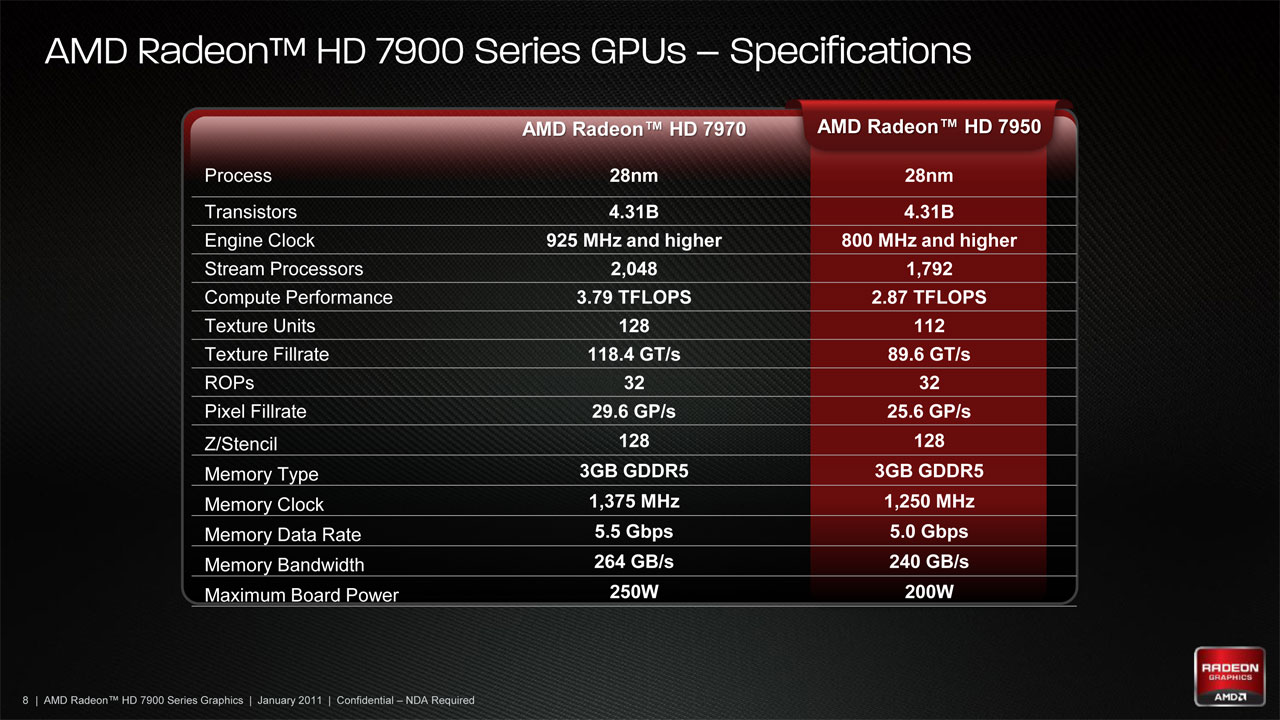
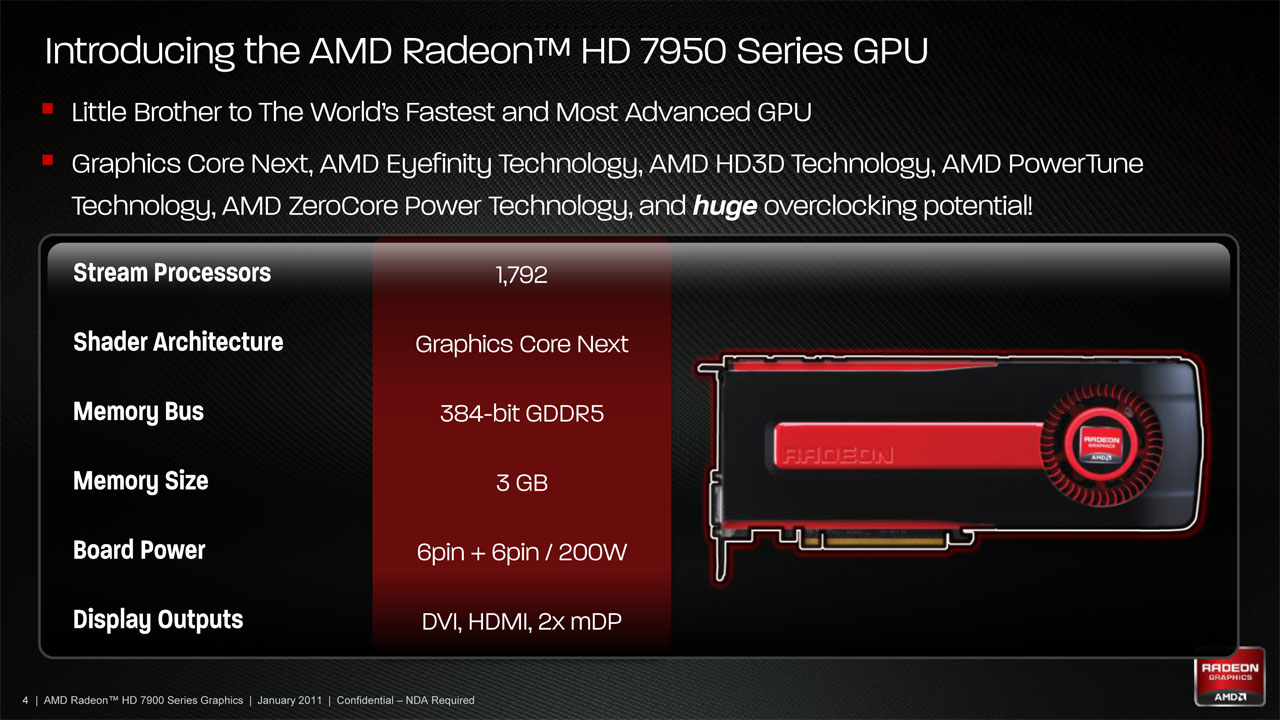
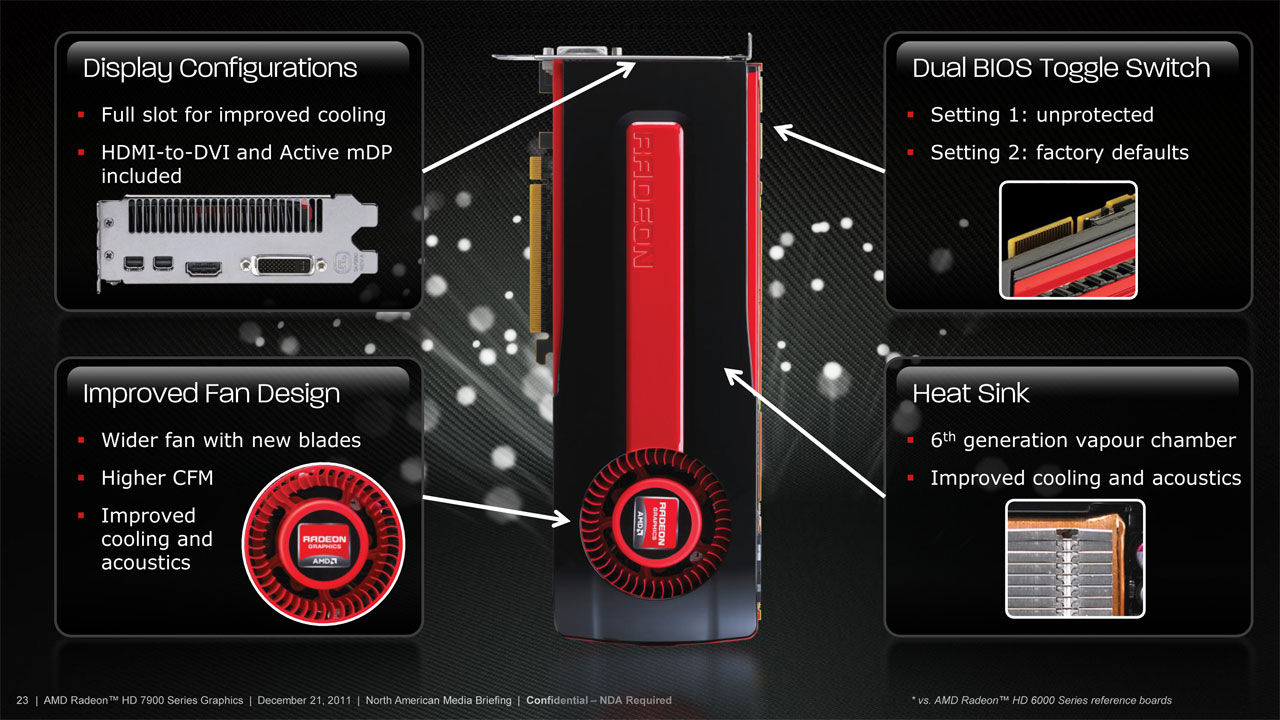
Specifications
The Radeon HD 7950 slots in just below the 7970, and like the 7970ups the ante in almost every regard versus the previous generation. It packs far more transistors onto the die, thanks to the 28nm process. Additionally, it ups the VRAM to 3GB, dramatically increases the shader count, and also increases the core clock. It does this for the same 200W profile of the Radeon HD 6950. Unfortunately, these improvements do bring a dramatically higher price.
| Card | GPUs | Transistors | Max Memory | Mem Bus Width | Shaders | Clock (MHz) | TDP (Watts)* | MSRP | ||
| Core | Mem | Idle | Max | |||||||
| AMD Radeon HD 7970 | 1 | 4.3B | 3GB | 384-bit | 2,048 | 925 | 1375 | <3 | 250* | $549 |
| AMD Radeon HD 7950 | 1 | 4.3B | 3GB | 384-bit | 1,792 | 800 | 1250 | <3 | 200* | $449 |
| AMD Radeon HD 6990 | 2 | 2 x 2.6B | 2 x 2GB | 2 x 256-bit | 2 x 1536 | 830 | 1250 | 37 | 350* | $699 |
| AMD Radeon HD 6970 | 1 | 2.6B | 2GB | 256-bit | 1536 | 880 | 1375 | 20 | 250* | $349 |
| AMD Radeon HD 6950 | 1 | 2.6B | 2GB | 256-bit | 1408 | 800 | 1250 | 20 | 200* | $279 |
| *These values represent the maximum wattage allowed through the AMD PowerTune. AMD estimates the average wattage draw for gaming is 190W/140W for the 6970/6950, respectively. Idle for the 7000-series is based on a "long idle" scenario. |
||||||||||
Overclocking
AMD is positioning the unit as having a large overclocking headroom. Even though the Engine Clock is reduced from 925MHz (in the HD 7970) down to 800 MHz in the Radoen HD 7950, AMD is still showing benchmark numbers at the 1GHz range. In addition their marketing slide deck for this release still contained the slide showing an operating range of 1GHz (and higher).
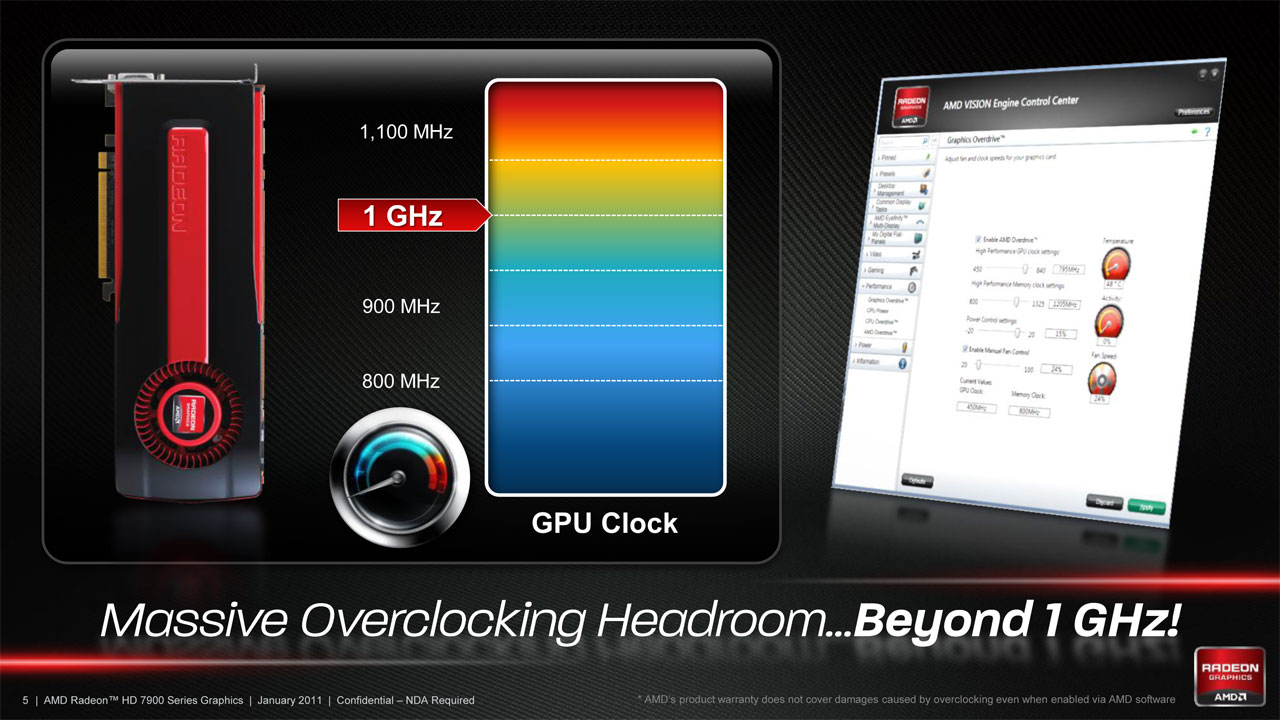

Power, Heat, Noise & Long Idle
One of the biggest updates with the new architecture is its improvements in power consumption, heat and noise. The improved fan design drastically improves the noise profile of the Radeon HD 7950. I run an open air case, and with the sytem in full benchmark mode, I couldn't discern the GPU noise over my CPU fan and my TV at low volume. Place this thing in an decent case, and it will be quieter than what most would expect.
Additionally, the 200W power draw is much cooler (at least 20%) than the 250W Radeon HD 7970. That translates into a much cooler operating temperature. I've dealt with the impact of high end cards raising the temperature in my office since I began benchmarking and testing. The temperature increase was far less noticeable this time around.
Finally I'm loving the Long Idle and ZeroCore improvements more and more. I use a Mac for my daily "productivity" usage (yea, yea, I know...), so I only fire up my PC for gaming. It was always frustrating to see how much heat was generated when I wasn't doing anything of any demand - downloading games on Steam is a perfect example. Now, with the power profile improvements, I can leave my machine downloading all night and wake to a still-cool office. Also, I wouldn't mind leaving my machine idling during the day so that I could jump into a game during my lunch break.
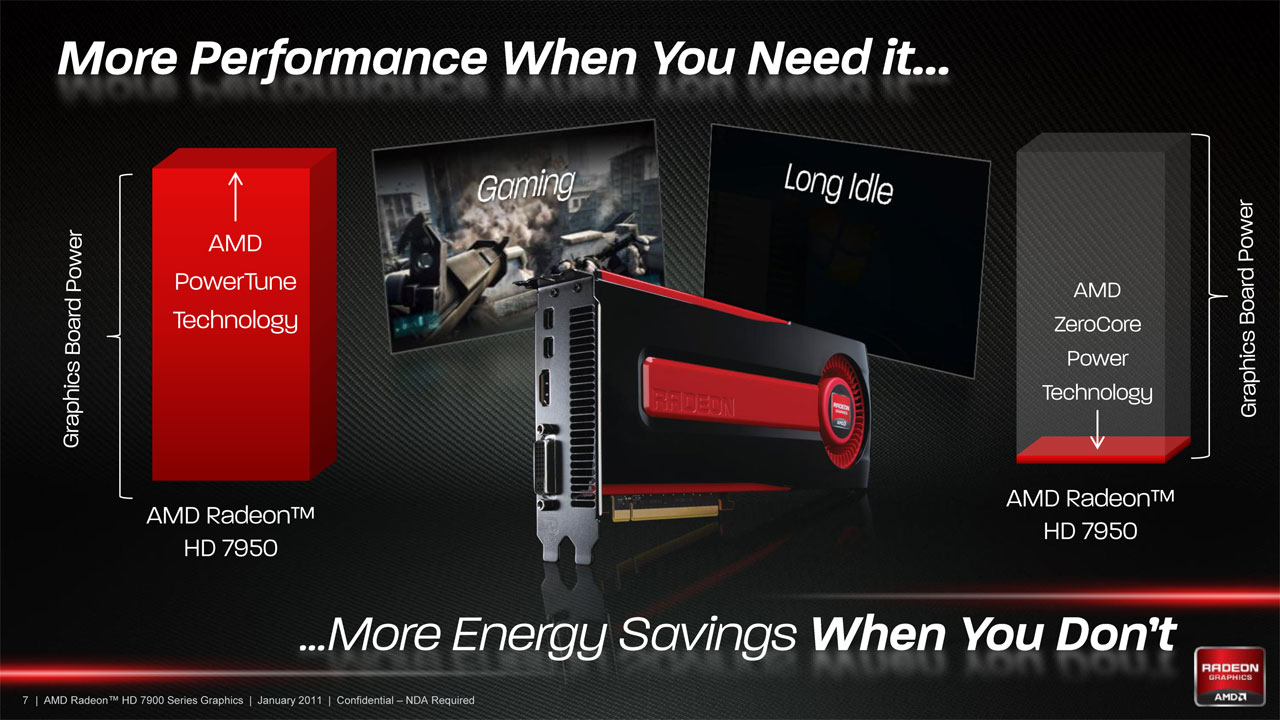
AMD Radeon HD 7950 Review - Benchmarking
System Specs
I have updated my resting rig, and moved from an Intel Core i7-920 to an i7-2600k. As before, everything runs at stock clock speeds. I have also increased RAM from 12GB to 16GB.
The Radeon HD 6970 and 6990 were tested with the Radeon HD 7970 release drivers. The Radeon HD 6950 and HD 7950 were tested with the Radeon HD 7950 release drivers. Supplies of the Radeon HD 7970 are scarce, so I don't yet have a 2nd one for CFX testing. However, I was able to pair up my Radeon HD 7970 with the Radeon HD 7950 for CFX testing on the Radeon HD 7950 platform.
At AMD's request, I also updated the Radeon HD 7970 benchmarks with the HD 7950 release drivers. They indicated that significant performance increases had been made in the new driver set for the HD 7970, and the previous benchmarks needed to be updated for a proper comparison. There may have been some advances in the Radeon 6000-series as well, so the HD 6970 and 6990 may be slightly understated.
- Windows 7
- ASUS P8Z68-V Pro/Gen3
- Intel i7 2600k at 4x3.4GHz
- 16GB G.Skill DDR3 1.25v low-voltage RAM
- 2x Samsung 320GB T-Series HDD (one for the OS and games; one for swap file and FRAPS)
- LG Super Multi Blu (HD-DVD/Blu-Ray Player)
- Onboard audio
- Corsair HX1000
- My Open PC Dragon Case
- Logitch K340 Keyboard & Performance MX Mouse
- Ergotech Heavy Duty Triple Desk Stand - WSGF Edition
- 3x Dell U2211H IPS 16:9 1920x1080 Displays
Hardware Tested
I only have AMD hardware tested for comparison in this review. This is not for lack of wanting to test NVIDIA hardware in Surround, but NVIDIA has not yet decided to support the WSGF with hardware for review and benchmarking. Considering that the WSGF is a hobby that just supports itself, I cannot justify spending the money needed to test NVIDIA cards.
Most of my time is spent working on the site (or other projects), and much of my "play time" is spent benchmarking. Cards would basically only be used for testing, and I cannot reconcile purchasing cards that would only be used for testing. It's simply not a good ROI.
Resolutions Tested
I tested both 1600x900 and 1920x1080 in widescreen, as well as 4800x900 and 5760x1080 in 3x1-L Eyefinity.
Games Tested
I have overhauled my suite of games. I replaced some older titles with their sequels, and I've simply dropped some titles either due to age or the time needed to benchmark. Additionally, I've dropped the DX9 and DX10 tests from the Heaven demo.
- Aliens vs. Predators
- DiRT 3
- H.A.W.X. 2
- Heaven v2.5 DX11
- Mafia II
- Metro 2033
- Total War: Shogun 2
As always, all games are tested at max settings (unless otherwise noted), with 4xAA and 16xAF enabled.
Future Testing
I will be retesting the HD 6700 and 6800 series on the new platform, in anticipation of new HD 7000 releases. Additionally, I'm going to look into the impacts of overclocking. And finally, I will be doing some more detailed testing and AA analysis considering the 3GB frame buffer on the card. How far can we push it until it breaks down? ^_^
AMD Radeon HD 7950 Review - Aliens vs. Predator
Still demanding DX11 benchmark that we've used for a while here on the WSGF. Though it's closing in on two years old, the AvP stand-alone benchmark tool is still a good test of DX11 hardware. It isn't very demanding from a CPU perspective, so it gives a good test of the GPU itself.
The AvP demo also makes good usage of DX11 effects such as Advanced Shadows and Geometry Tessellation, particularly on the alien create and the alien "pods". There are also some unique lighting effects used, by placing mobile lighting sources in a floor lamp that is battered around by the alien creatures as they clamor down a tight hallway.

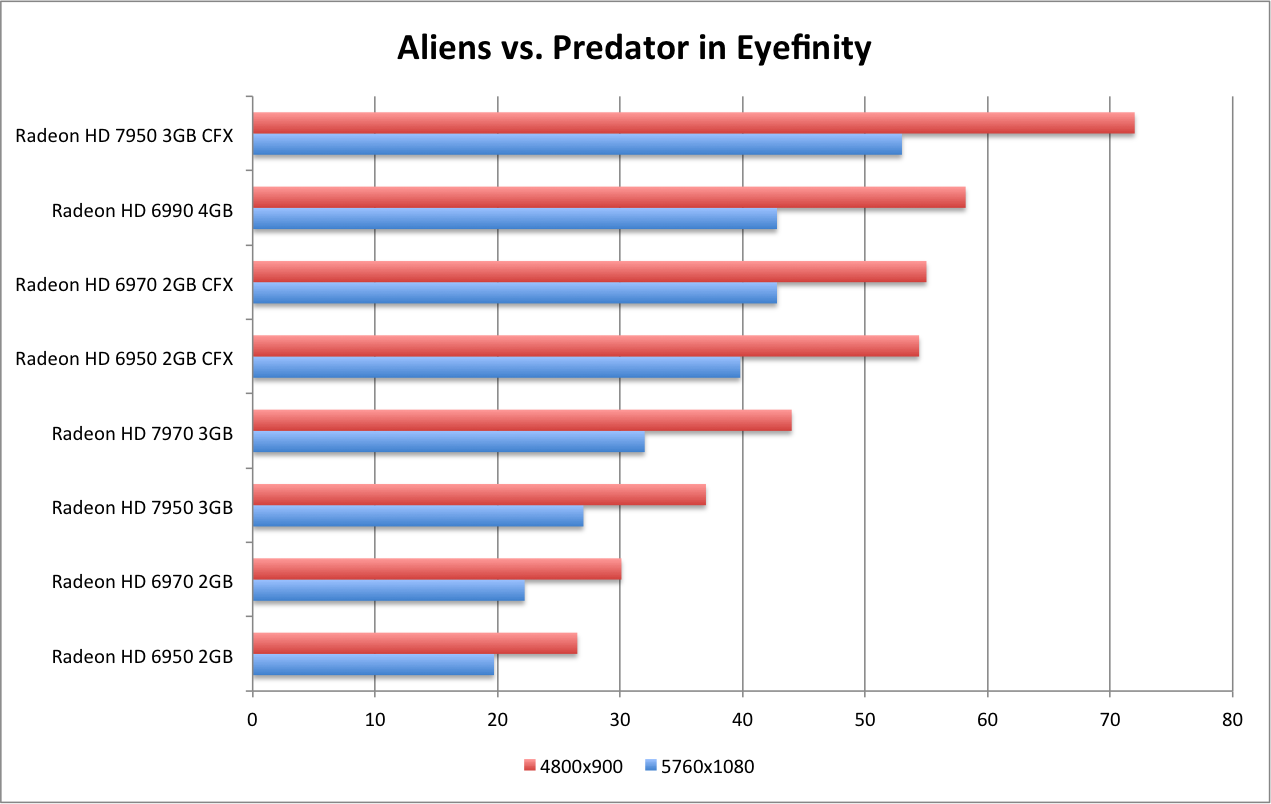
AMD Radeon HD 7950 Review - DiRT 3
Dirt 3 has replaced our previous benchmark of Dirt 2. The Dirt 2 benchmark was the "urban" London circuit, which had several nice examples of water tessellation for the gar to drive through. The Dirt 3 benchmark we use is the Aspen track, which is a long winding snow course.
Rather than water and cloth effects in Drt 2, the Dirt 3 course showcases snow covered trees that flank a snow-covered course with tessellation effects on the snow tracks gouged into the snow. Additionally, there are continuous snow particles kicked up from the cars, and a better chance to see cars flipping and skidding. Overall, a nice and "pretty" update to our Dirt 2 benchmark.
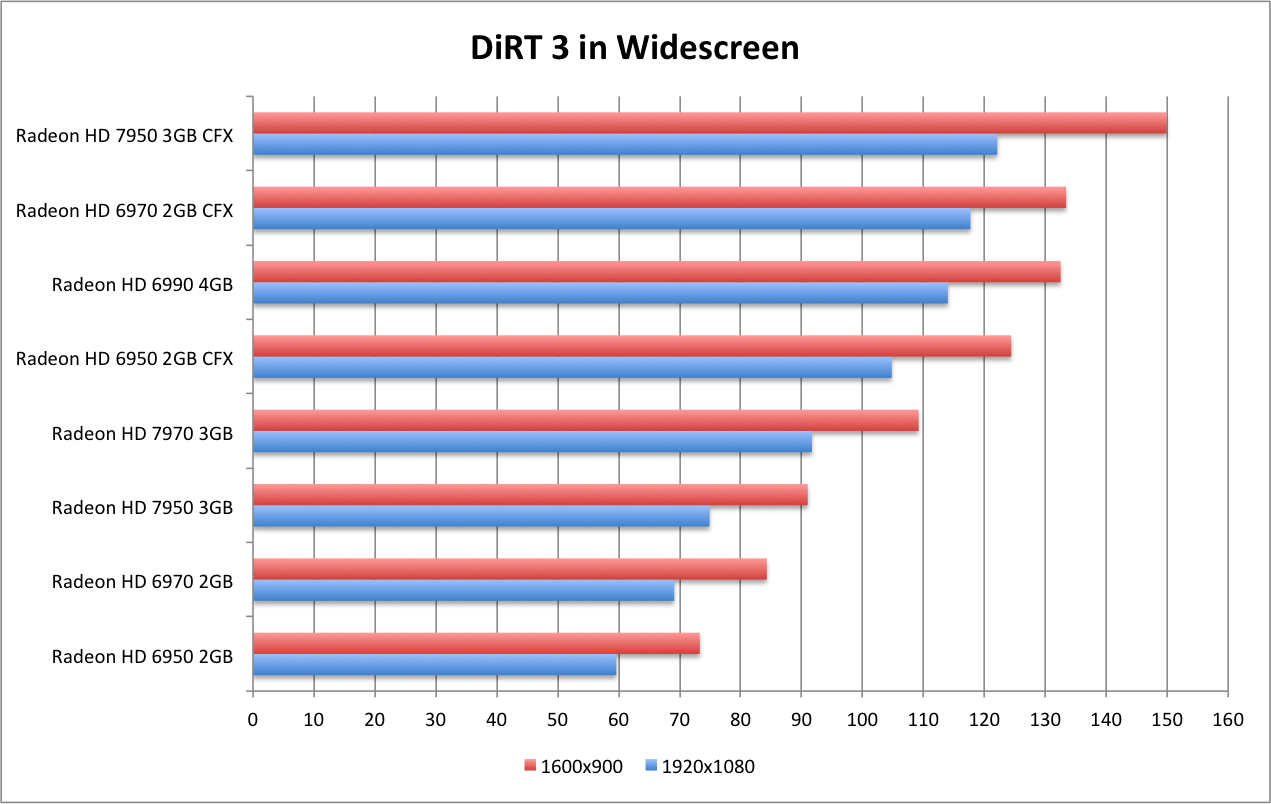
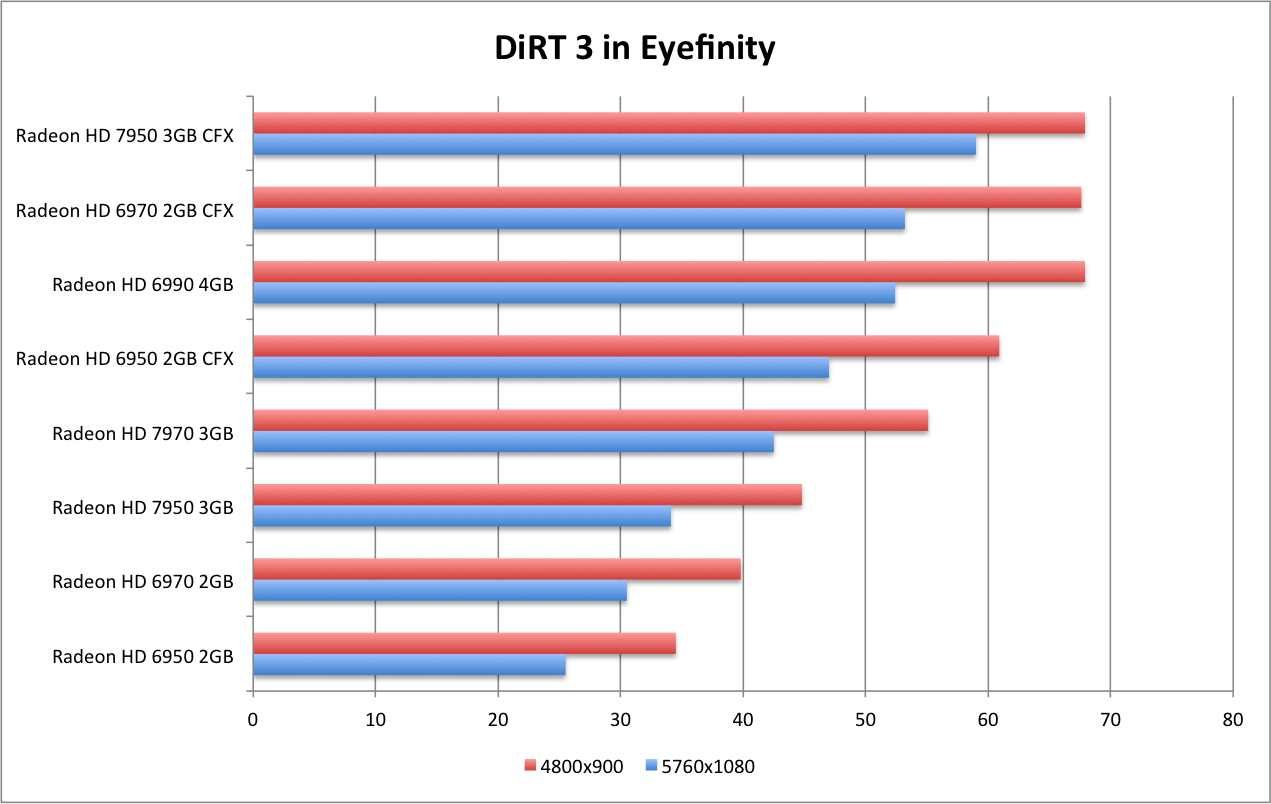
AMD Radeon HD 7950 Review - H.A.W.X. 2
Sequel to the original HAWX title. This title updates the original by moving from DX10 to DX11, and utilizing tessellation on the mountainous landscape. The original HAWX demo provided a simple camera fly-through of an area populated by detailed cities and waterways. The "action" consisted mostly of ground explosions and some aircraft engagement.
The HAWX 2 demo removes the cities and water, and focuses on very detailed snow-covered mountain range with a large fleet of aircraft firing missiles. The viewpoint of the camera alternates between a third-person view over the top of a jet, as well as a first-person view inside the same craft.
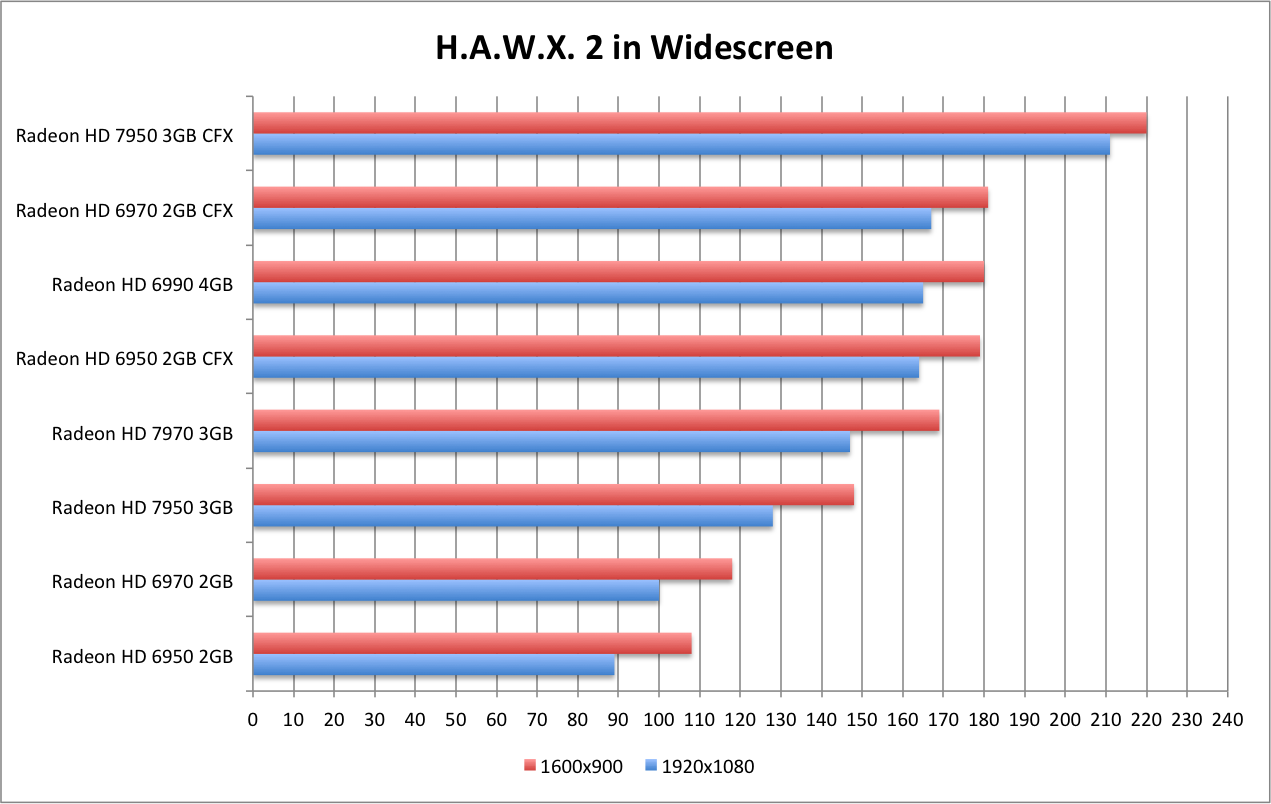
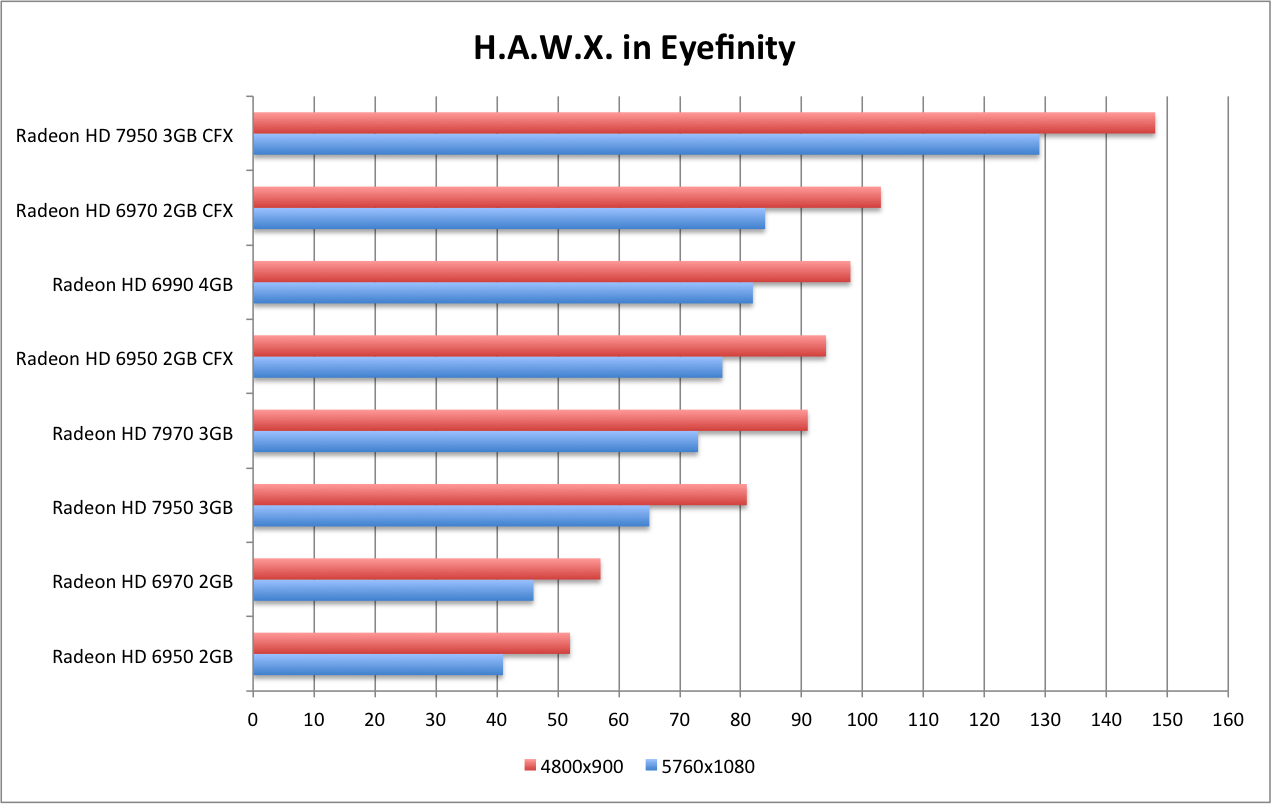
AMD Radeon HD 7950 Review - Heaven v2.5 DX11
Update to the Heaven v2 demo, that has been an long-standing benchmark for many people. Though it's largely the same as the v2 demo, it does add a couple of new set pieces - particularly a new airship. This title is more demanding than the previous iteration, and adds a new tessellation options.
The Heaven demo continues to offer options for testing in DX9, DX10 and DX11 code paths. We have narrowed our testing to DX11, and are no longer testing the DX9 and DX10 code paths. The DX9 and DX10 were more CPU dependent and less of a test of the strength or weakness of the GPU. The DX11 truly stresses a GPU.
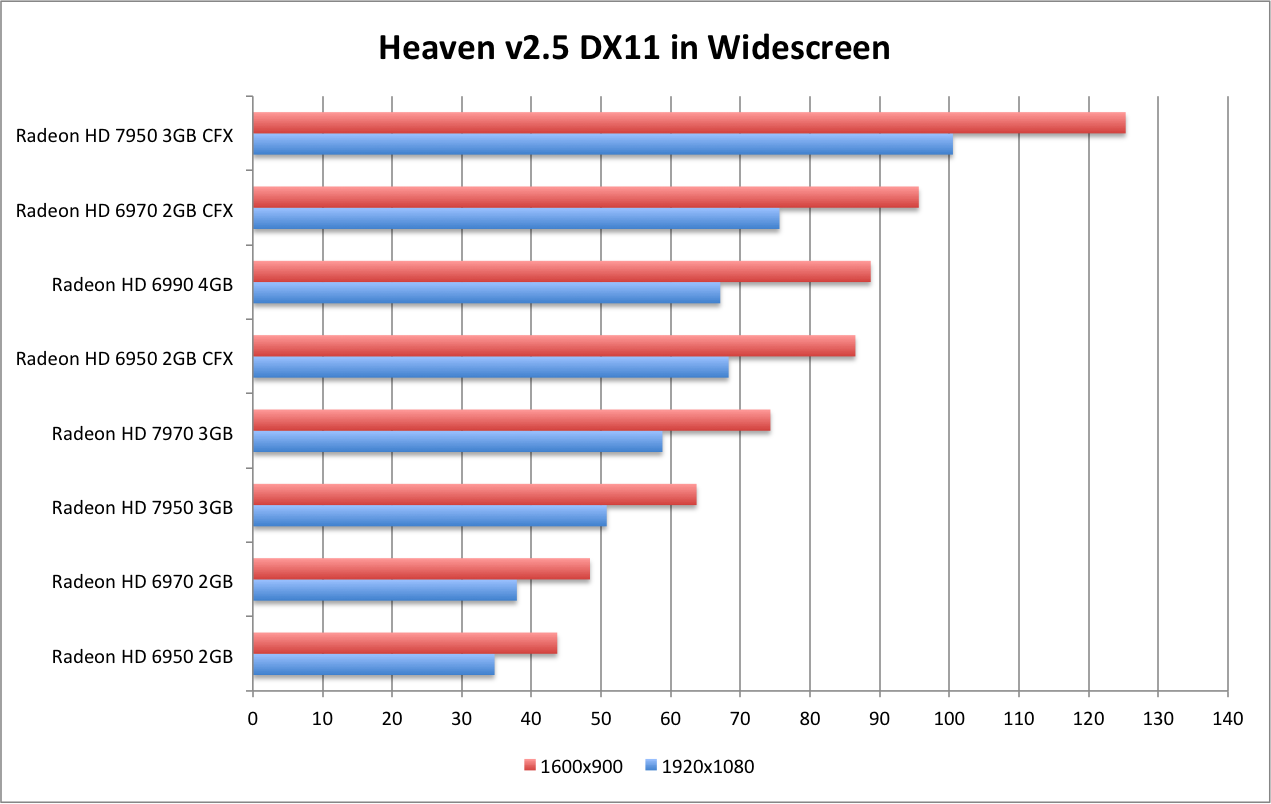
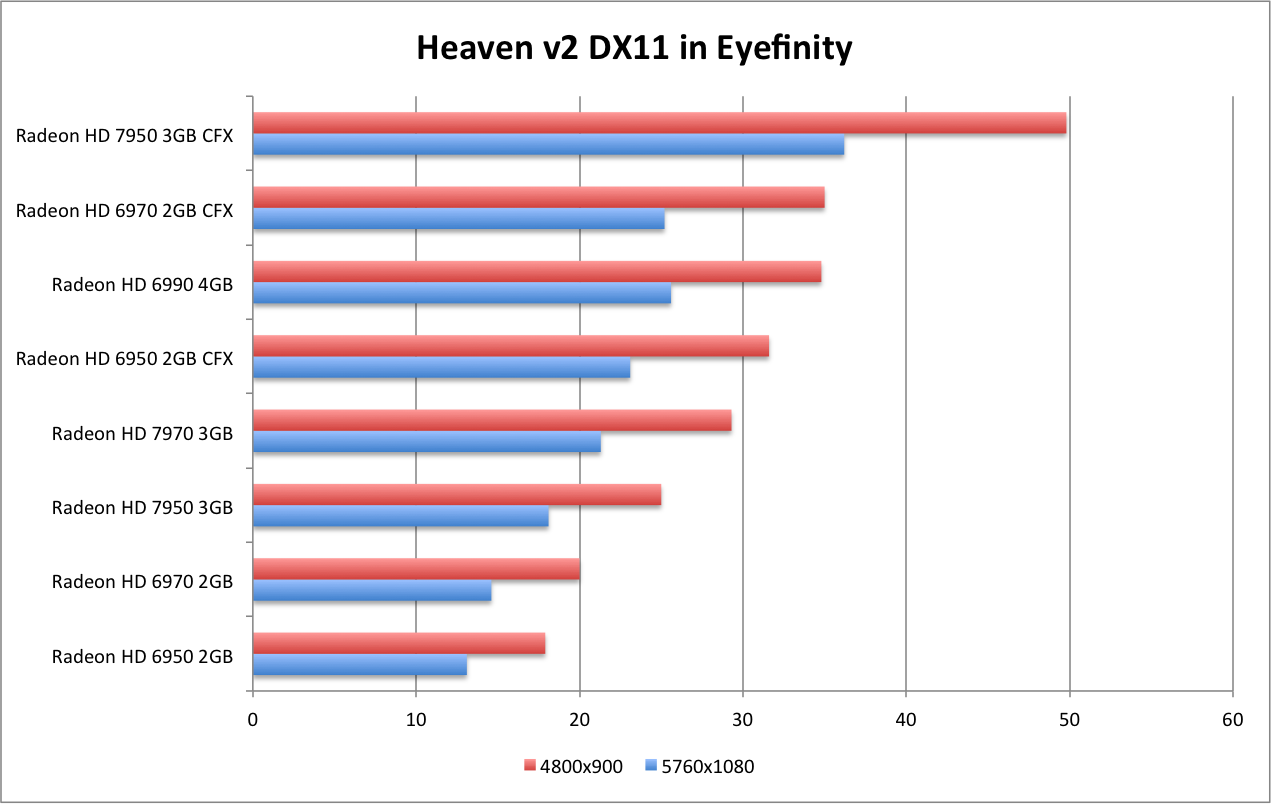
AMD Radeon HD 7950 Review - Mafia II
Demanding benchmark that is included in the Mafia II open-world crime title. The title begins with an exterior gunfight, highlighting cars losing parts and being destroyed. The demo then moves inside a warehouse which highlights a gun battle, with destructible environments (brick columns) and excellent flame effects.
One thing to note is that the demo performs much better on a second run-through. The first run shows noticeable hiccups during the loading of different scenes. Subsequent runs run much smoother, though the overall average isn't seriously effected.
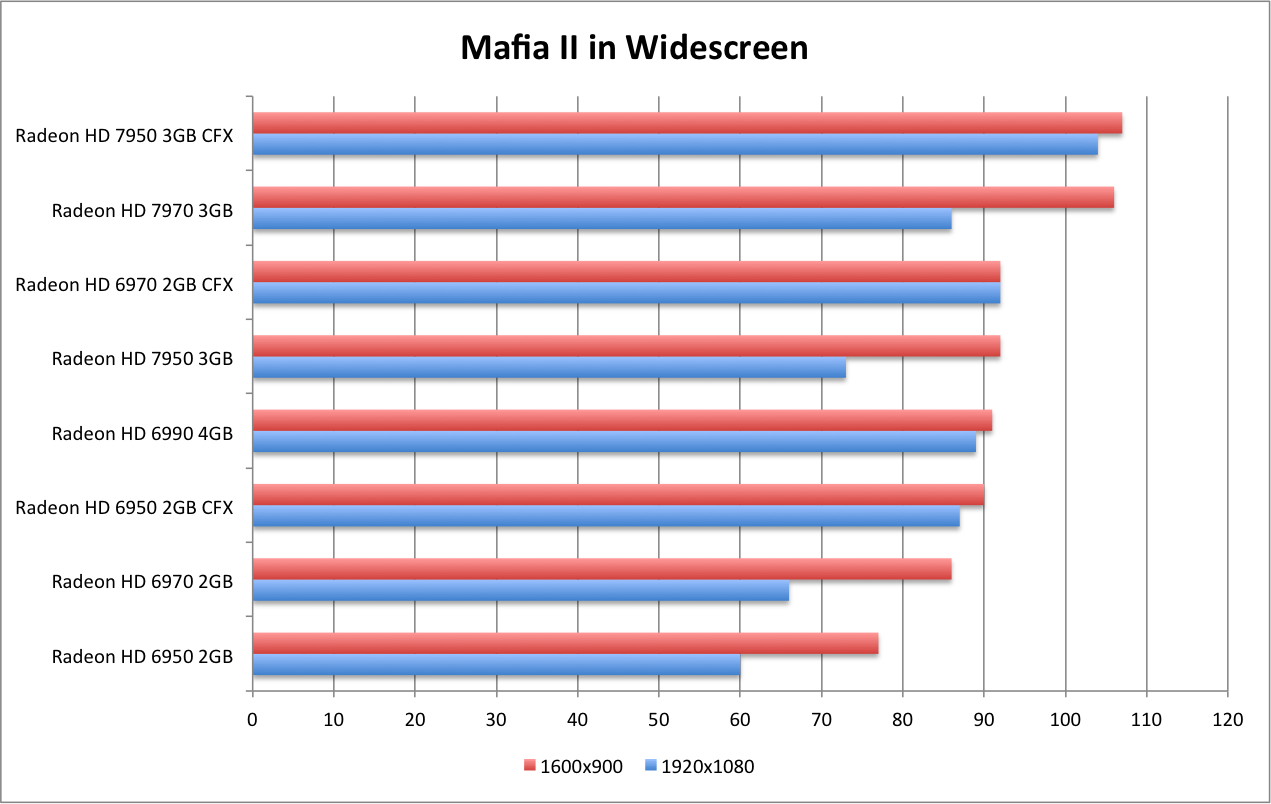
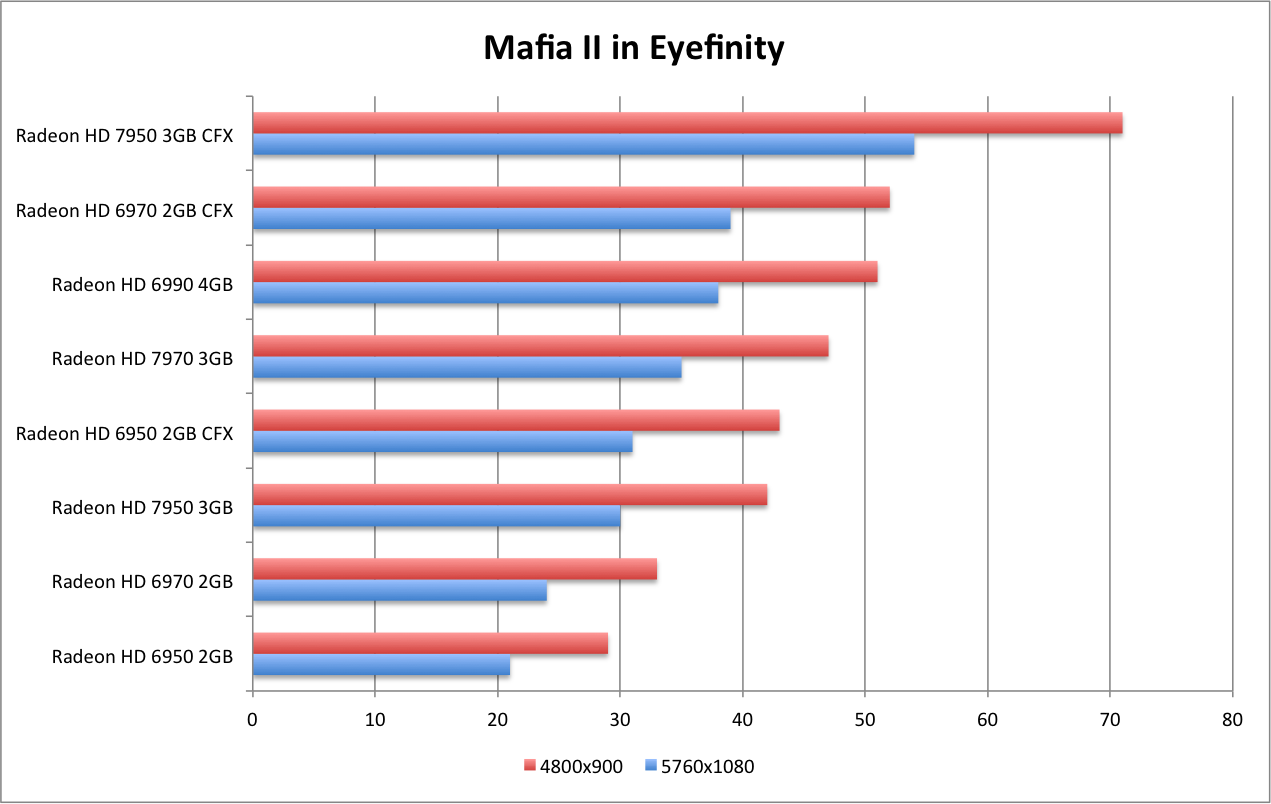
AMD Radeon HD 7950 Review - Metro 2033
Demanding benchmark that is included in the popular FPS, Metro 2033. The demo is a camera fly through in a subway tunnel. There are large amounts of gunfire, cloth and lighting effects. The demo has a number of noticeable slowdowns from heavy flame, fog and motion blur effects. We run the game on the DX11 code path.
One a single GPU we see a number of dips, similar to Far Cry 2. When running in CrossFire multi-GPU, I do see noticeable micro-stuttering.
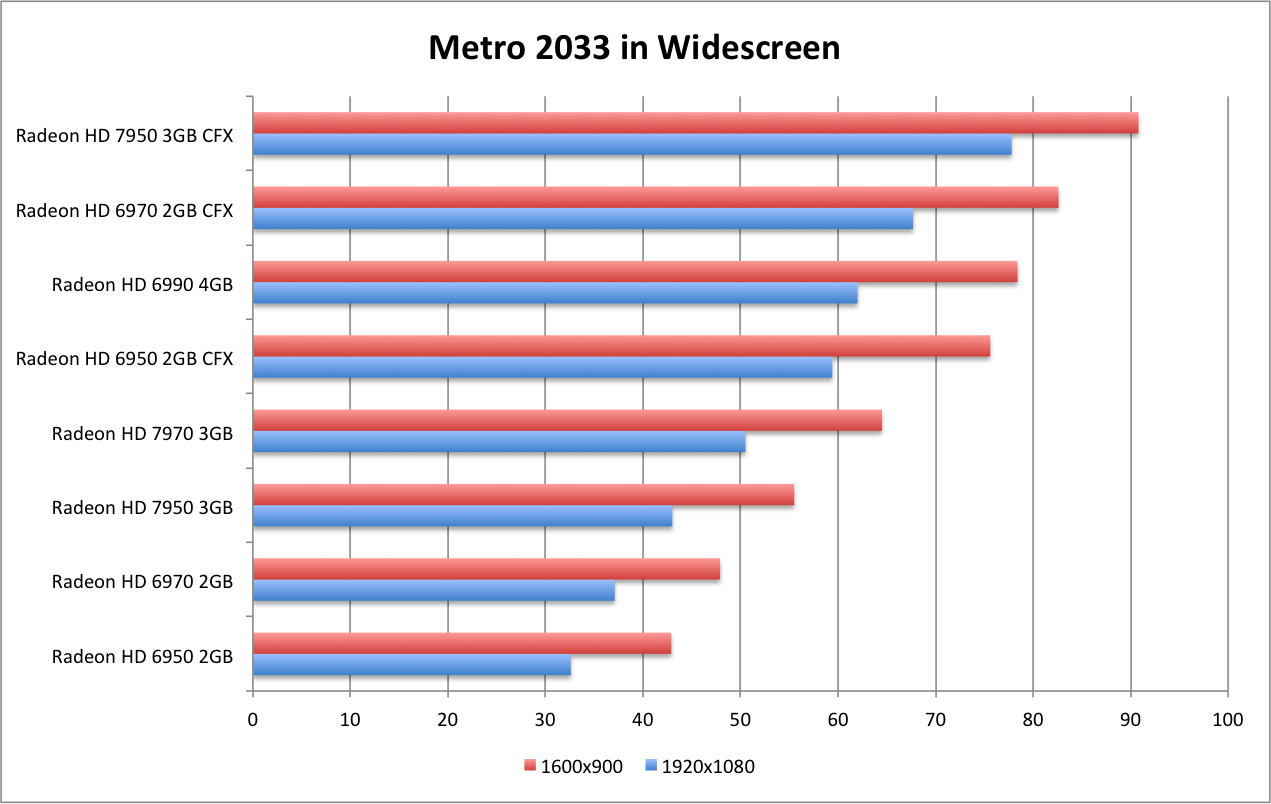
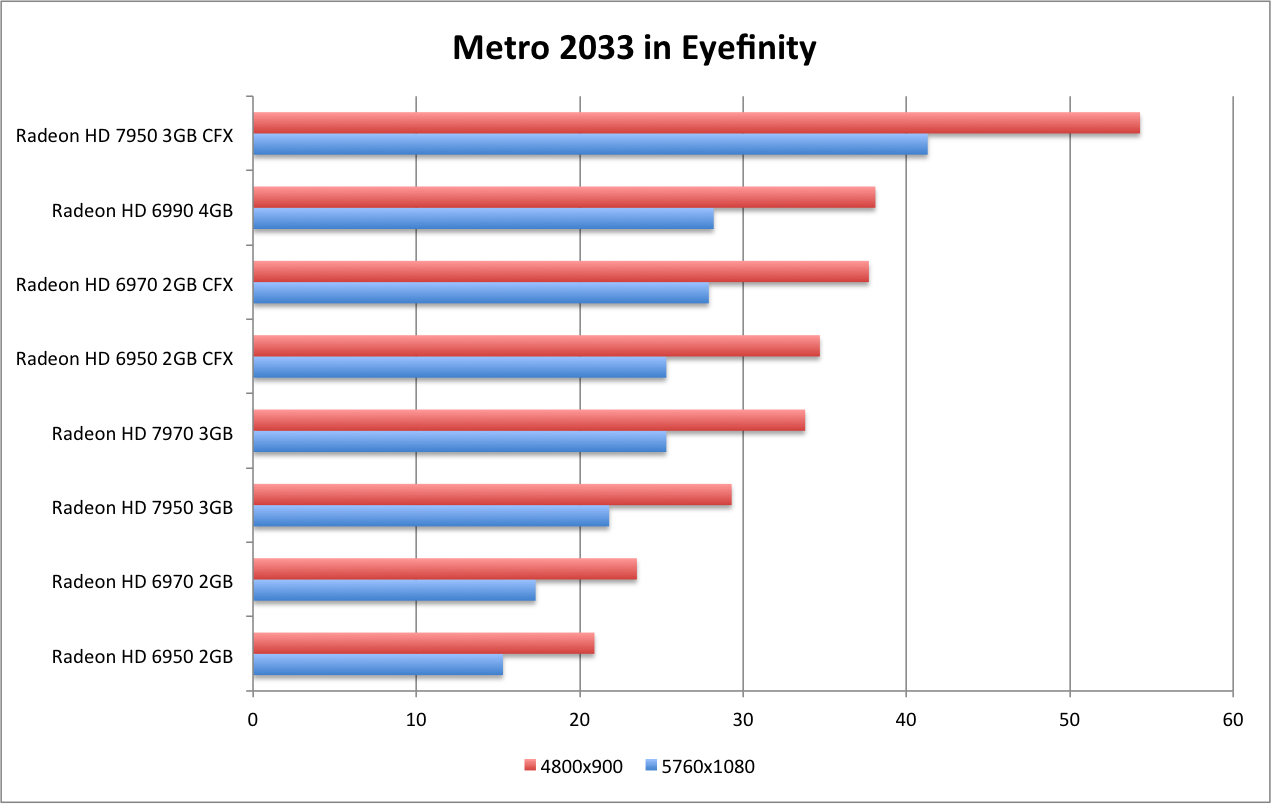
AMD Radeon HD 7950 Review - Total War: Shogun 2
Benchmark that is included in Total War: Shogun 2. This is the one instance we are not running at full "max" settings with 4xAA/16xAF. The benchmark simply will not run at these settings in Eyefinity on any 1GB card. To enable a consistent benchmark across all cards I've used these settings: "Very High" preset, 2xAA, and all the DX11 options turned on.
The title showcases a number of scenes - both broad views of large scale battles (with large numbers of units), and highlighting the detail in marching columns of soldiers.
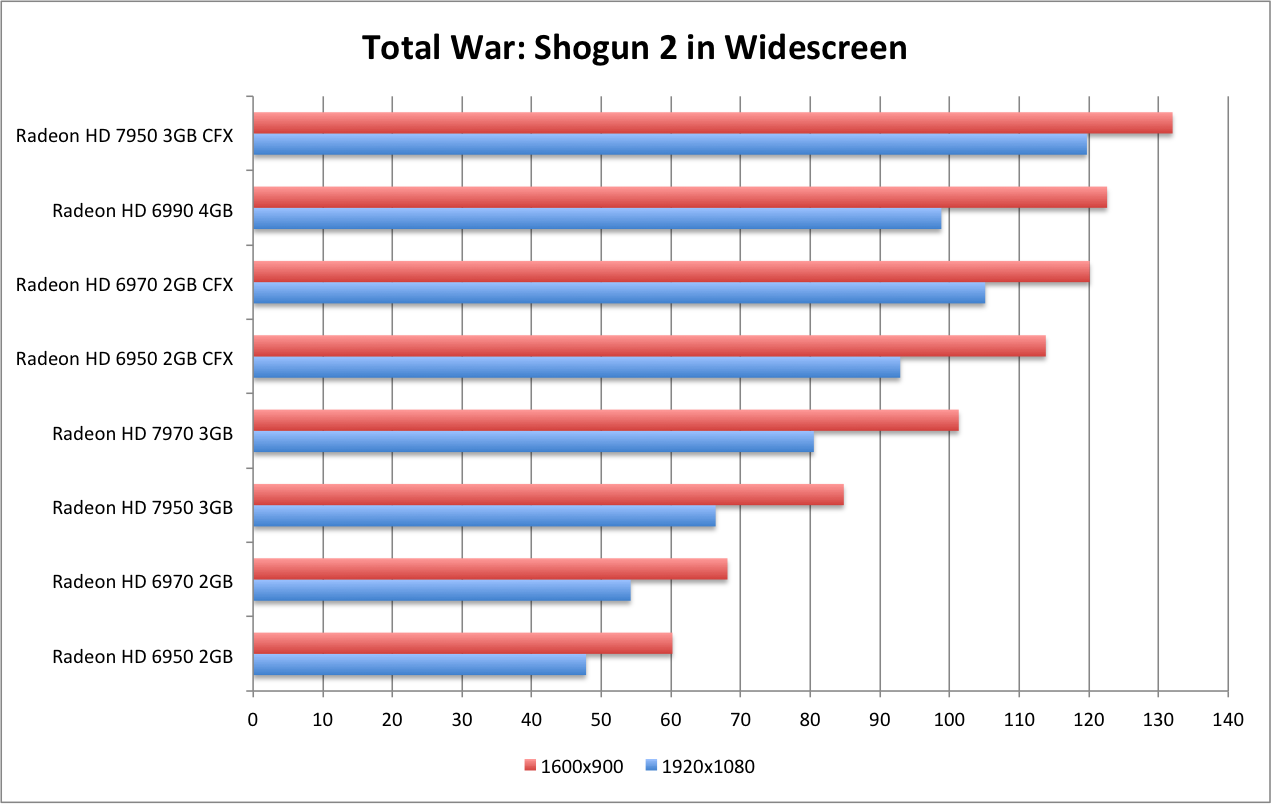
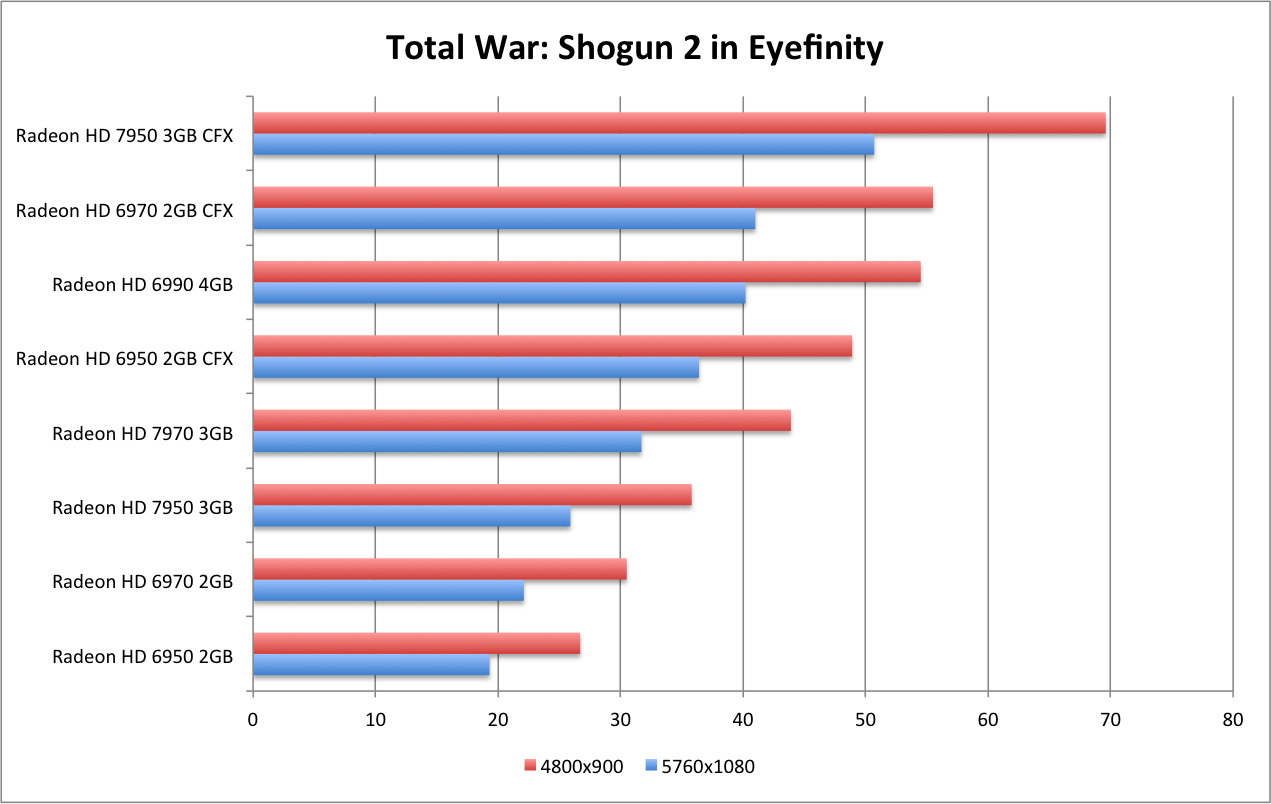
AMD Radeon HD 7950 Review - Driver Improvements
As part of this review, I updated the benchmarks for the Radeon HD 7970. This was done at the request of AMD, due to improvements in the card's performance with the updated drivers.
The claims were that improvements up to 10% were seen in selected games. I have updated the numbers for the Radeon HD 7970, and show the comparisons here
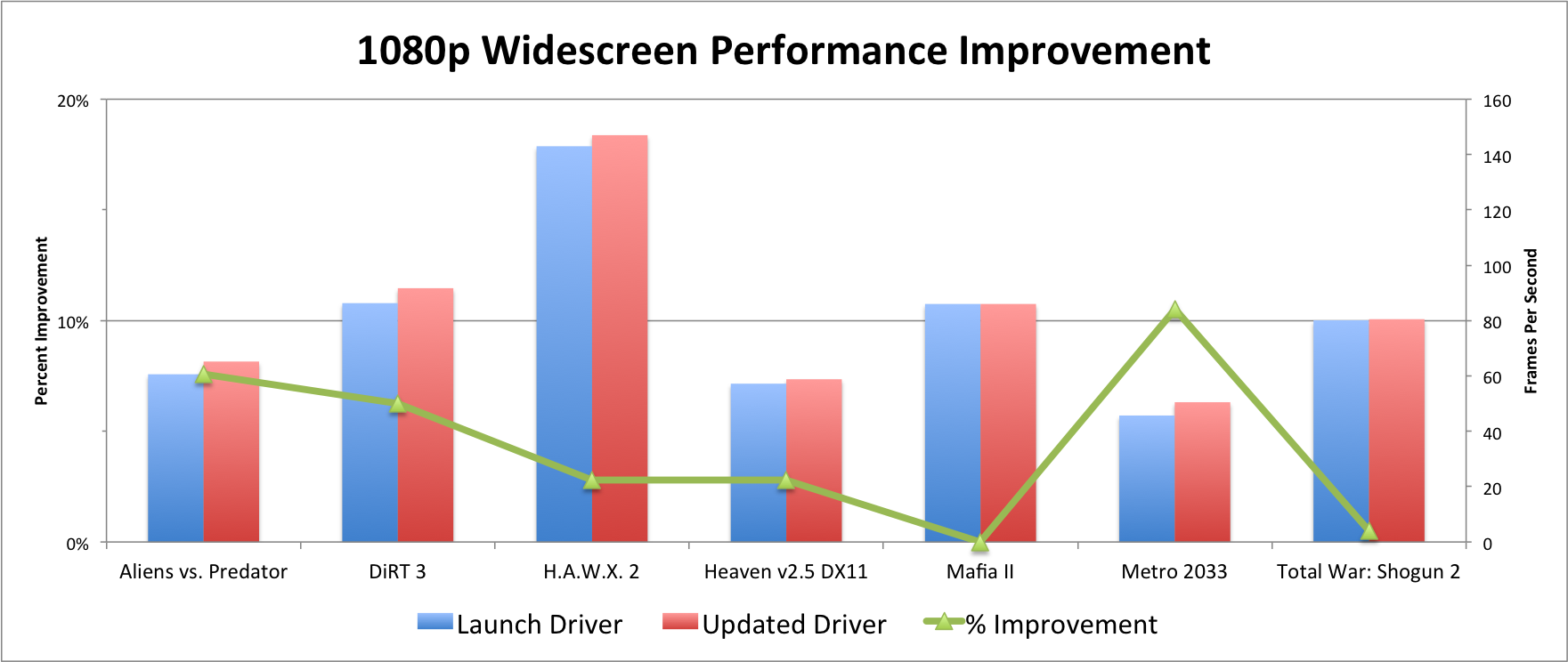
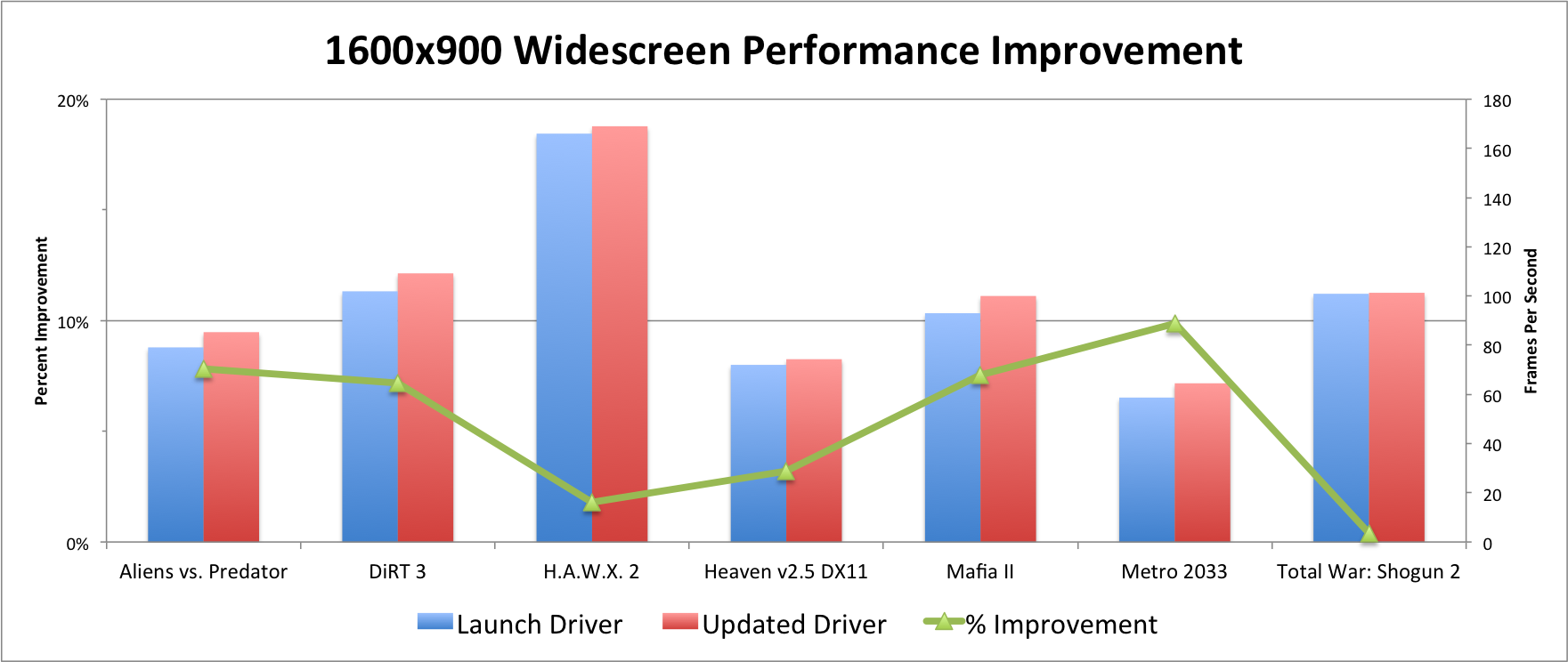
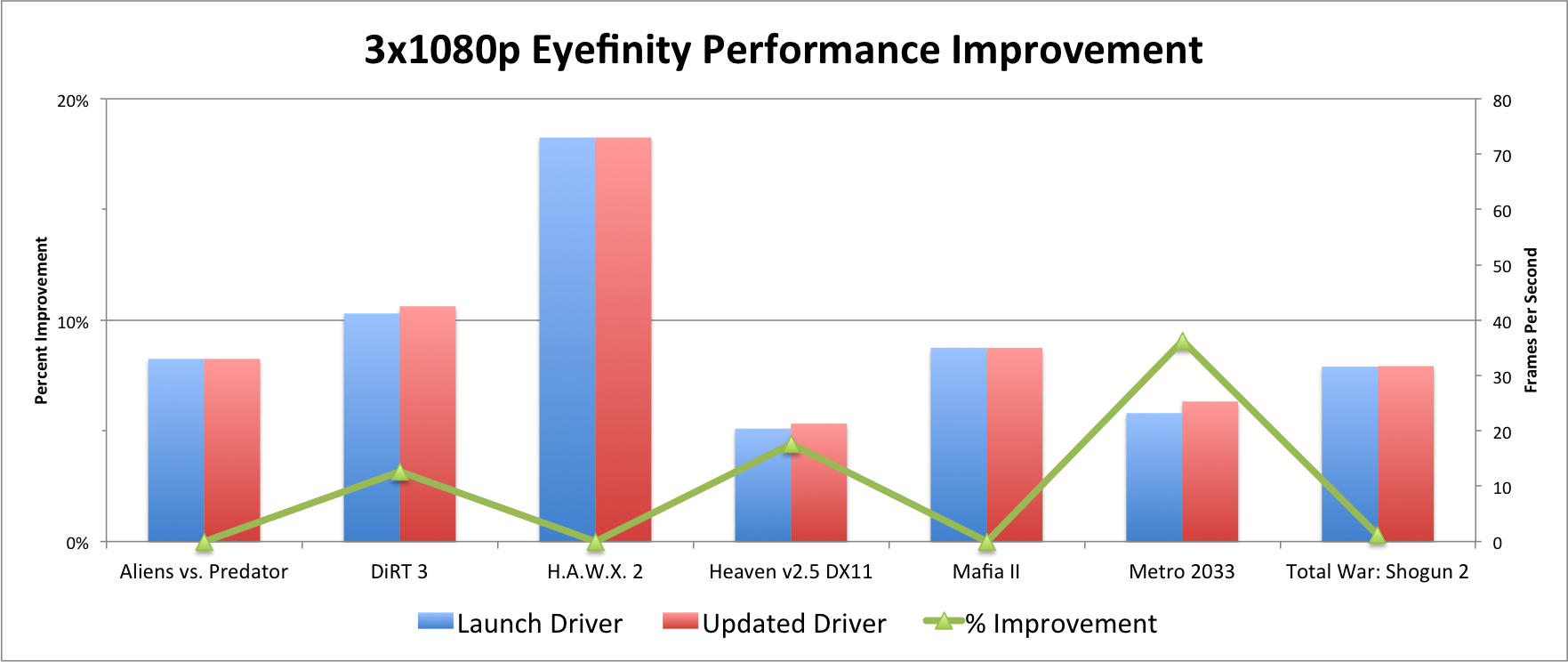
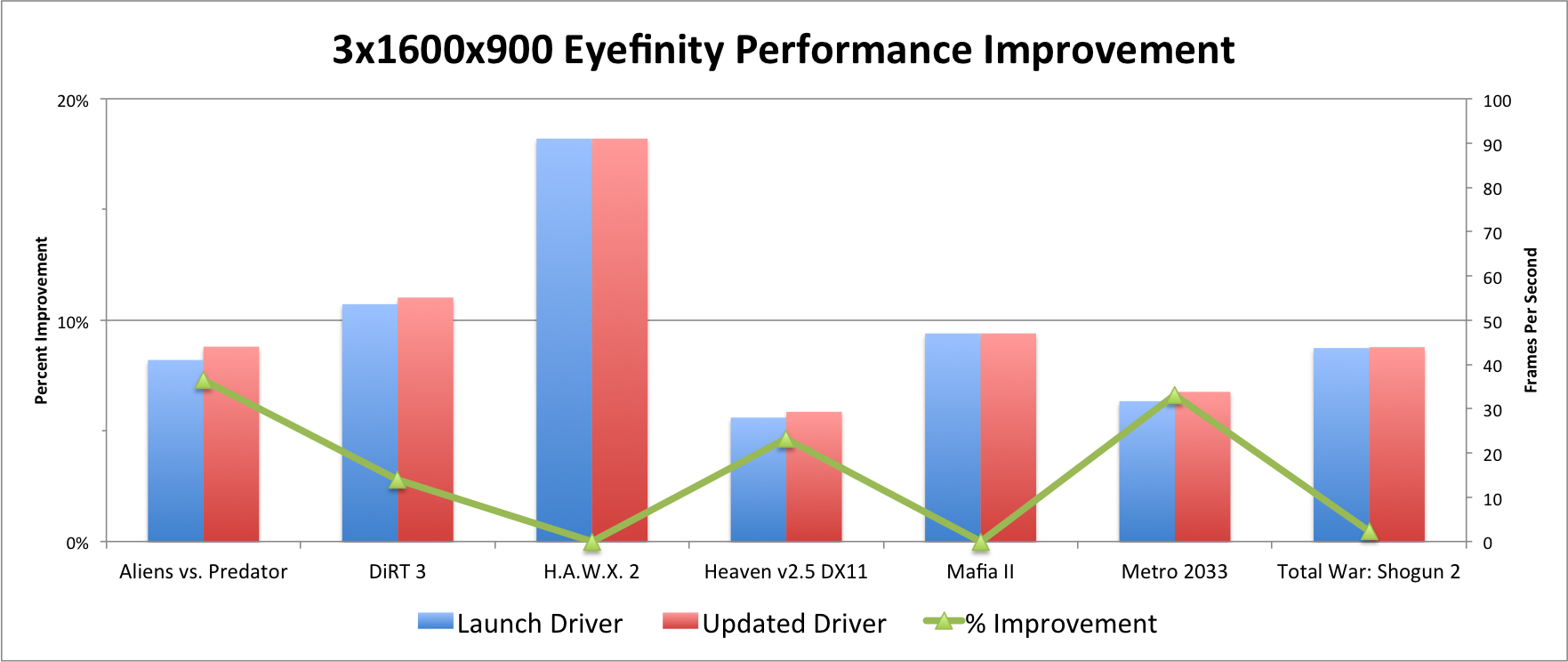
Overall there are some decent games in a few of our titles. A total weighted average (adding up all the frames in each "set", and comparing the totals) shows 4% - 5% improvement in widescreen performance, and 2% improvement in Eyefinity performance.
Granted these weighted averages are pulled down, due to no improvements in several titles. There are noticeable improvements in AvP, Dirt 3 and Metro 2033. If you play these titles, changes are you will notice (and appreciate) the improvements.
AMD Radeon HD 7950 Review - Final Thoughts
Comparing the Radeon HD 7950
There are a number of ways to compare the Radeon HD 7950, as there are plenty of cards and combinations (single and CFX) for comparison. However, I think there are two comparisons to stand out. First, comparing the Radeon HD 7950 to the flagship Radeon HD 7970. Second, comparing the Radeon DH 7950 to the card it replaces - the Radeon HD 6950.
The Radeon HD 7950 is launching at $449. This is roughly 61% over the current price of the Radeon HD 6950. And, it is about 22% less than the Radeon HD 7970. So, is the HD 7950 a 60% faster card, than the HD 6950? And, is it a 20% slower card than the Radeon HD 7970?
| Price | 1080p Widescreen | ||||||||||
| Price | vs. HD 7950 | AVP | Dirt 3 | H.A.W.X. 2 | Heaven 2.5 | Mafia II | Metro 2033 | Shogun 2 | Total | ||
| AMD Radeon HD 7970 | $549 | 22.3% | 18.8% | 22.4% | 14.8% | 15.7% | 17.8% | 17.4% | 21.2% | 18.1% | |
| AMD Radeon HD 6950 | $279 | 60.9% | 35.6% | 25.7% | 43.8% | 46.4% | 21.7% | 31.9% | 38.9% | 34.8% | |
| Compared to the Radeon HD 7950, priced at $449. | |||||||||||
|   | Price | 1080p 3x1-L Eyefinity | |||||||||
| Price | vs. HD 7950 | AVP | Dirt 3 | H.A.W.X. 2 | Heaven 2.5 | Mafia II | Metro 2033 | Shogun 2 | Total | ||
| AMD Radeon HD 7970 | $549 | 22.3% | 18.5% | 24.6% | 12.3% | 17.7% | 16.7% | 16.1% | 22.4% | 17.5% | |
| AMD Radeon HD 6950 | $279 | 60.9% | 37.1% | 33.7% | 58.5% | 38.2% | 42.9% | 42.5% | 34.2% | 43.3% | |
| Compared to the Radeon HD 7950, priced at $449. | |||||||||||
So, what do these charts tell us? They say that while the Radeon HD 7970 is 22% more expensive than the Radeon HD 7950, it "only" provides an 18% performance improvement in widescreen and a 17.5% improvement in Eyefinity. Those numbers are pretty close, and your only paying a 5% "premium" for the biggest and best card in the 7000-series.
When looking at the card it replaces, the Radeon HD 7950 is almost 61% more expensive than the Radeon HD 6950. However, it only offers a 35% performance improvement in widescreen, and only offers a 43.5% improvement in Eyefinity. Now improvements of 35% and 43% are a sizable improvement over the previous generation, but they don't match the 61% price increase.
Now, frame rates aren't the only thing to consider in a video card, and the Radeon HD 7950 (like the HD 7970) brings a number of additional features such as the improvements in noise, heat, power draw and overclocking headroom. The question remains on whether you think those features are worth 20% of price increase, or will you wait for a price drop and/or the next card in the lineup.
Final Thoughts
The Radeon HD 7950 scorches in widescreen, offering 60fps+ at max settings in almost every game at 1080p, and offering 30fps+ at 1080p Eyefinity.
The Radeon HD 7950 is a solid release in the new 7000-series, and its price/performance ratio fits in nicely with the HD 7970. There is certainly a price premium for entry into the Radeon 7000-series, but I think the improvements in the noise, heat and power are well worth the price premium over the Radeon 6000-series.
The Radeon HD 7950 scorches in widescreen, offering 60fps+ at max settings in almost every game at 1080p. For the few that are just under 60fps, this bellwether is easily within reach. If you are a widescreen gamer I would recommend the 7950 over the 7970. Save the $100, and put it toward a couple of new games to enjoy. My opinion is that for single screen the Radeon HD 7970 is just overkill. If you're shooting for 1080p 60fps, this is your card.
The same hold true if you are satisfied with 30fps in Eyefinity. The Radeon HD 7950 will give you 30fps+ in almost every title I tested at max settings. If you're looking to join the Eyefinity ranks and are on a budget, I would recommend savings the money here and putting that $100 towards one of your monitors. The overclocking headroom will help for sure, and the CrossFire performance is excellent. You can pick up a second HD 7950 in a year when prices fall, and more demanding games are being released.
Pricing the Radeon HD at $399 would have put it right at a 43% price premium over the Radeon HD 6950 it replaces. If the launch price is a bit too steep for you, then a future price drop of $50 would get you the perfect price/performance ratio over the last generation. However, I think the environmental improvements of quieter and cooler running are well worth the $50 premium.